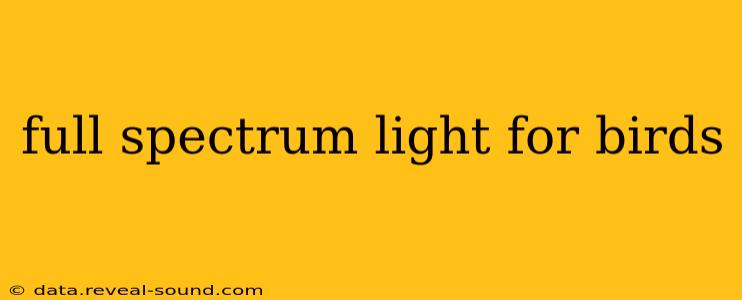Full spectrum lighting is becoming increasingly popular among bird owners, touted for its benefits in promoting bird health, well-being, and vibrant plumage. But what exactly is full spectrum light, and how does it benefit our feathered friends? This comprehensive guide will delve into the science behind full spectrum lighting for birds, exploring its advantages, potential drawbacks, and how to choose the right lighting for your avian companions.
What is Full Spectrum Light?
Full spectrum lighting aims to mimic natural sunlight, providing a broader range of wavelengths than standard incandescent or fluorescent bulbs. Unlike traditional bulbs that emit light primarily in a narrow band, full spectrum lights replicate the ultraviolet (UV), visible, and infrared (IR) light found in sunlight. This broader spectrum is crucial for birds, as they perceive light differently than humans.
Why is Full Spectrum Light Important for Birds?
The benefits extend beyond simply providing adequate illumination. Full spectrum lighting plays a significant role in several aspects of a bird's health and well-being:
-
Vitamin D3 Production: UVB light is essential for birds to synthesize vitamin D3, vital for calcium absorption and strong bones. Deficiencies can lead to metabolic bone disease (MBD), a severe and often fatal condition.
-
Improved Feather Quality: The full spectrum of light, including UV, can contribute to brighter, healthier plumage. Birds with access to full spectrum light often exhibit more vibrant colors and less feather loss.
-
Enhanced Breeding Behavior: For breeding birds, full spectrum lighting can help stimulate natural breeding cycles and improve reproductive success. The appropriate light cycle mimics seasonal changes, influencing hormonal balance.
-
Increased Activity and Alertness: Adequate light levels generally lead to more active and alert birds. This is especially important for birds kept indoors, preventing lethargy and behavioral problems.
-
Boosting Immunity: While research is ongoing, some studies suggest that full spectrum lighting can positively impact the bird's immune system.
What are the Different Types of Full Spectrum Lights for Birds?
Several types of full spectrum lights are available for birds:
-
Compact Fluorescent Lamps (CFLs): These are a relatively affordable option and offer a good spectrum of light, but their lifespan may be shorter than LEDs.
-
Light Emitting Diodes (LEDs): LEDs are increasingly popular due to their long lifespan, energy efficiency, and the availability of various color temperatures and spectra specifically designed for birds.
-
Metal Halide Lamps: These produce a very bright light, often used in larger aviaries, but require specialized fixtures and can generate significant heat.
It's crucial to choose bulbs specifically designed for avian use, as not all full-spectrum bulbs are created equal. Look for bulbs with a stated UVB output and a color temperature suitable for your bird species.
How Much Full Spectrum Light Do Birds Need?
The ideal amount of light varies depending on the species of bird and its natural habitat. However, a general guideline is to provide 10-12 hours of full-spectrum light per day, mimicking natural daylight cycles. You should also incorporate a period of darkness for rest.
What are the Potential Drawbacks of Using Full Spectrum Lights for Birds?
While generally beneficial, some potential drawbacks include:
-
Heat Generation: Some bulbs, particularly metal halides, can generate significant heat, potentially causing overheating, especially in smaller enclosures. Proper ventilation is crucial.
-
Cost: High-quality full spectrum bulbs, especially LEDs, can be more expensive than standard bulbs.
-
UVB Degradation: UVB output diminishes over time, so regular replacement is essential to ensure continued effectiveness.
Does Full Spectrum Light Cure Diseases?
No, full spectrum lighting is not a cure for diseases. It's a supportive measure promoting overall health and well-being. It's crucial to consult an avian veterinarian for any health concerns.
Can I Use Full Spectrum Bulbs for Other Pets?
While full spectrum lights benefit birds significantly, their applicability to other pets varies greatly. Reptiles, for example, also require specific UVB wavelengths, but the requirements differ substantially from those of birds. Research the specific needs of your pet before using full spectrum lighting.
How Often Should I Replace Full Spectrum Bulbs for My Bird?
Manufacturers usually specify the lifespan of their bulbs. However, it's wise to replace them every 6-12 months, even if they still appear to be functioning, to ensure optimal UVB output and prevent potential deficiencies. Regularly monitor your bird's health and feather condition for any signs of deficiencies.
By carefully considering the type of light, the appropriate duration, and regular bulb replacement, you can provide your feathered friends with the best possible environment, fostering health, happiness, and vibrant plumage. Remember to always consult with an avian veterinarian for species-specific recommendations.
